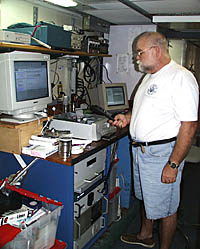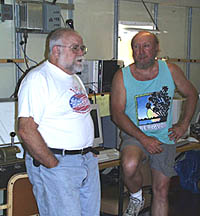Interviews:
Jim Charters
 Jim works in the geophysical equipment room, better known as “The Cave.”
This is where all the electronics for the multibeam sonar, gravimeter, and shipboard computer system are housed.
Jim also does the SeaNet satellite transfers from this location. Here, he dials the satellite to transmit and receive data for
the Dive and Discover website. Jim works in the geophysical equipment room, better known as “The Cave.”
This is where all the electronics for the multibeam sonar, gravimeter, and shipboard computer system are housed.
Jim also does the SeaNet satellite transfers from this location. Here, he dials the satellite to transmit and receive data for
the Dive and Discover website.
Question:
What did you want to be as a kid?
Jim:
I have no idea! But I did like building and fiddling with things, so
I majored in Engineering at Arizona State University. They didn’t
have Computer Engineering at that time, so I got a degree in Industrial
Engineering. I actually started programming computers in 1964 when computers
were room size.
Question:
Have you found it difficult to keep up with all the changes and developments
in computers over the years?
Jim:
No, not really. Since I use computers all the time, it has been pretty easy for
me to keep leaning new computer languages and constantly updating my knowledge
of the latest hardware.
Question:
What are your main responsibilities on board?
Jim:
I am in charge of keeping the ship’s computer systems in tip-top shape,
and making sure all the science computers are collecting good data and working
properly. I am particularly concerned that we collect good SeaBeam bathymetric
data. I have been involved with SeaBeam since 1981, and am probably responsible
for about half the plotting software the scientists use to map the seafloor.
It is also my job to send the e-mail out twice a day, and to transfer the SeaNet
files to Woods Hole that are being used to make the Dive and Discover web site.
 |
 |
| Jim
Charters (left), the Shipboard Computer Technician, and
Ron Comer, the Scripps Resident Technician, provide the
technical support for scientists on board the ship. Their
help is key to getting the most science done. |
Question:
What do you do on a typical working day at sea?
Jim:
I make sure all the computers are running and that they are collecting
data and logging it. I also do some initial data processing to make
sure that the data are being logged correctly, and that there are
no problems with the SeaBeam mapping. At the beginning of cruises,
I also spend a good deal of time teaching scientists and students
how to operate the different computer systems. I don’t have
an official watch. I guess you could say that I am on call for 24
hours a day. During my free time, I read books a lot -- usually murder
mysteries and suspense novels.
Question:
How did you end up working at Scripps?
Jim:
I had been working for the aerospace industry and they were in a recession --
so I was out of a job. Scripps was the first place to offer me a job. I was unemployed
and really needed it. I have been there ever since.
Question:
What do you like most about your job?
Jim:
I like getting to take care of all the different parts of the ship’s operating
systems, and the computer hardware and software. I have a wider range of duties
out here than I would back at Scripps on land. It’s also nice to be making
the extra sea pay while I’m out here!
Question:
What do you like the least?
Jim:
Being at sea! It’s difficult being away from home for 5-6 months each year.
Question:
What sort of computer system do you have at home?
Jim:
I don’t! My wife has a PC, but I avoid them as much as possible. That’s
not my idea of having fun!
Back to main interviews page
|


